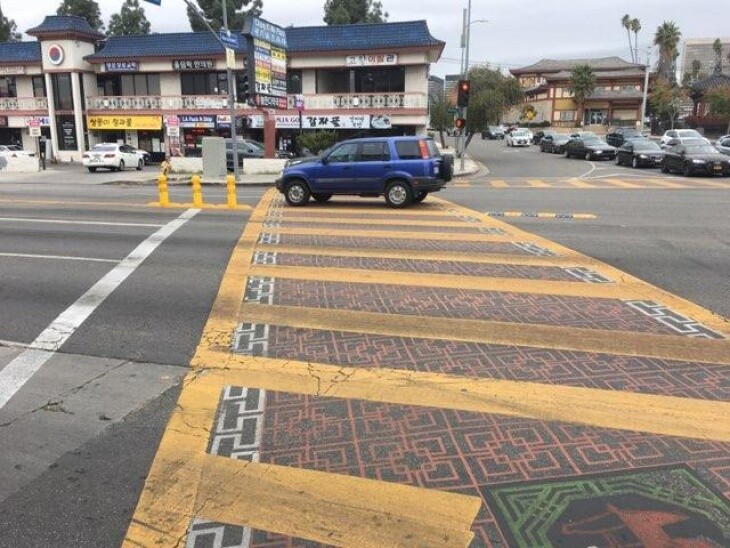Our news is free on LAist. To make sure you get our coverage: Sign up for our daily newsletters. To support our non-profit public service journalism: Donate Now.
On Monday, we published my reporting on the death of Alessa Fajardo, a 4-year-old girl who was killed by a driver while walking to school with her mother in October of 2019.
In the roughly 15 months since Alessa died, her parents, Erica and Jaime Fajardo, have been waiting for the woman who killed their daughter to be held accountable -- and for the city to make safety improvements on Olympic Blvd. and Normandie Ave. in Koreatown.
Shortly after Alessa was killed, city workers restriped the crosswalks at the intersection, but as I reported, further improvements remained pending or unfunded.
Then on Wednesday morning, workers with the Los Angeles Department of Transportation installed new safety features at the intersection, including at the crosswalk where Alessa died.
One key change: retiming the signals to give people walking a head start to cross the road, known as a Leading Pedestrian Interval, or LPI. The Federal Highway Administration (FHA) calls LPIs a "proven safety countermeasure" that's been shown to reduce vehicle-pedestrian collisions by 13%.
The second feature is known as centerline hardening, or left-turn calming, and is designed to improve pedestrian safety by extending the center dividing lines of streets past the crosswalk and into the intersection. That's accomplished with rubber strips and plastic bollards, which force drivers to make wider, slower left turns.

Both upgrades represent an engineering approach known as "self-enforcing streets." The FHA reported that roadways designed this way "can be effective in producing speed compliance and may contribute to less severe crash outcomes."
As I reported earlier this week, the city has known and documented for years that the intersection where Alessa was killed is especially dangerous for pedestrians -- particularly for children who walk to the school on the corner, like Alessa did.
Left-turn phasing -- as in traffic signals with green arrows that limit the time drivers can turn left-- has also been approved for the intersection. But there is currently no timetable for when those new signals will be installed, according to LADOT spokesperson Colin Sweeney.
Sweeney also confirmed that the upgrades were all recommended as a result of the department's review of the incident in which Alessa died. That review was completed in July 2020, he said.
Since Alessa was killed on Oct. 16, 2019, I've been asking LADOT how it plans to address the dangers there. Sweeney told me late last year that centerline hardening was "expected" to be installed early this year, but did not mention LPIs. That feature was first proposed for the crosswalks there under a Safe Routes to School plan, which was denied funding in 2018.
Sweeney provided this statement from LADOT:
"Every life lost as a result of traffic violence is tragic and heartbreaking, especially when we lose a life that's only just begun. We extend our deepest condolences to the Fajardo family and remain committed to doing everything we can to prevent more families from suffering such a loss."

"Why do they have to wait for something like this to happen, when a life is taken away?" she said.
Over the summer, Fajardo emailed the city's Vision Zero team, sharing her family's loss and asking for left-turn arrows and other upgrades, but never heard back from anyone. She hopes the city will do more to make streets safer for all Angelenos, regardless of where they live.
"I do have to think about the safety of my other two kids, and I think about the other kids who live around me," she said. "I have to be the voice for my other kids ... set the example for them, and let Alessa be heard."
You can read my story about Alessa Fajardo and her family's quest to hold accountable the driver who killed her -- and the city that manages the road where she died.
READ MORE ABOUT ALESSA AND TRAFFIC VIOLENCE:







